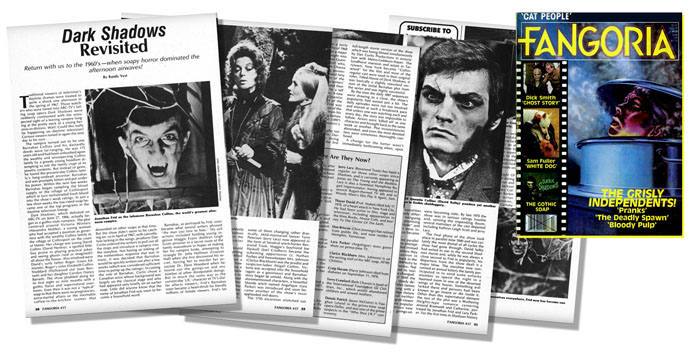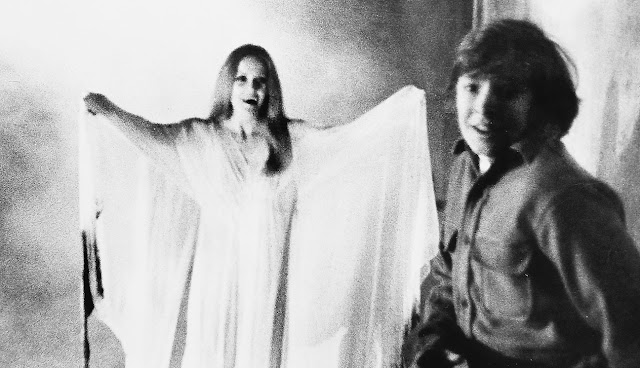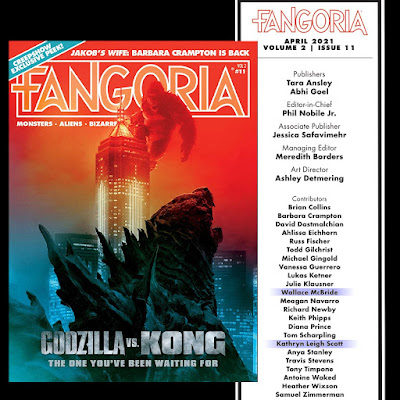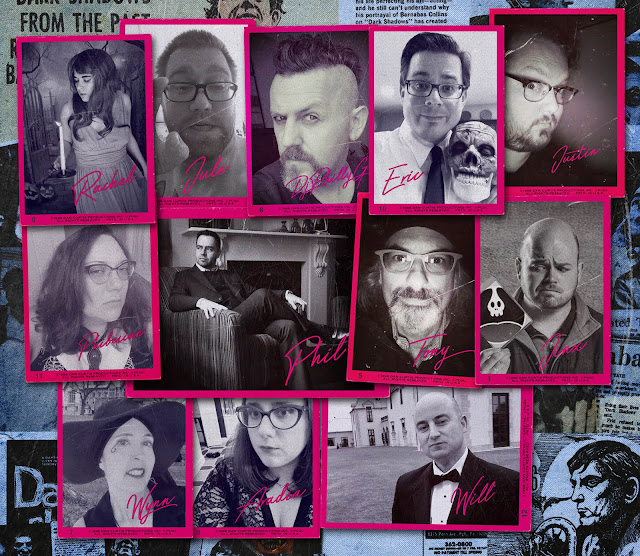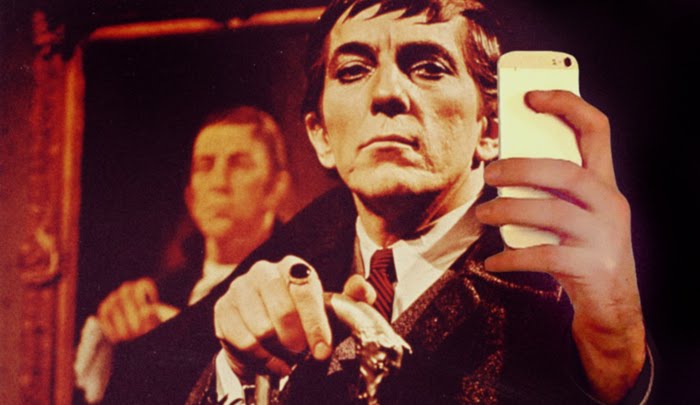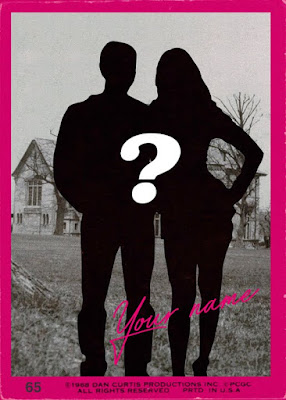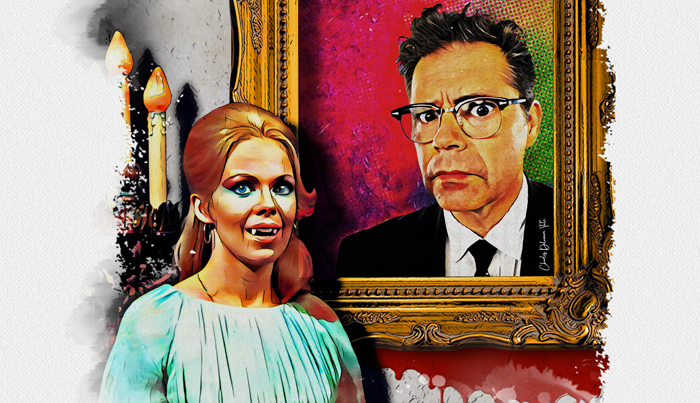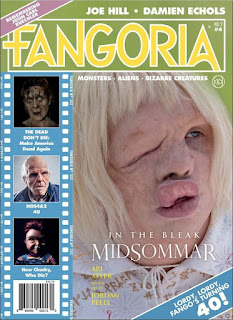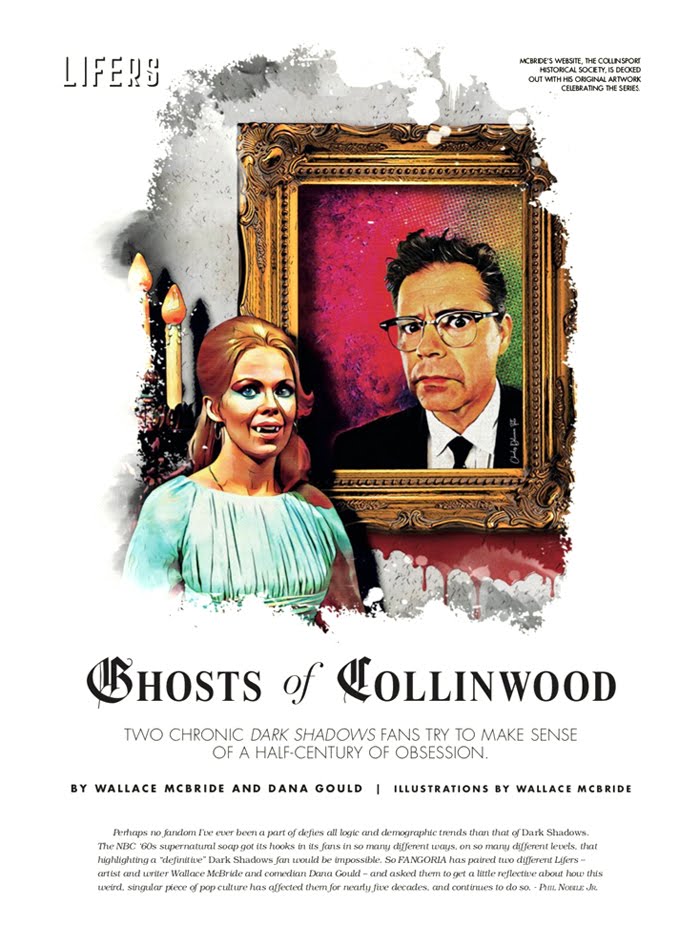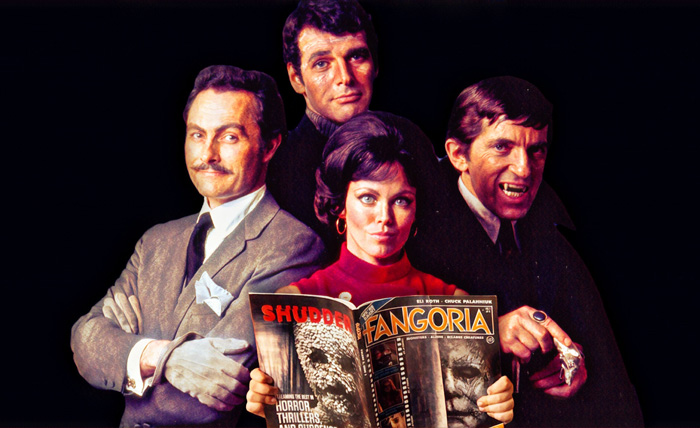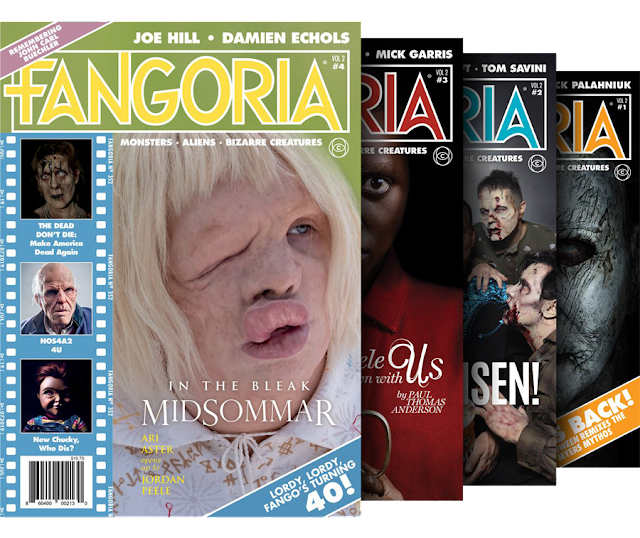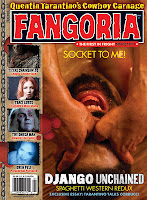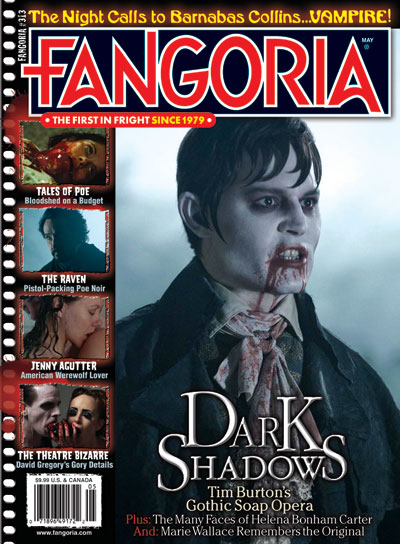
Everybody's pretty excited about the return of
Fangoria. The world has been slowly sliding into an intangible, indescribable Lovecraftian horror in recent years, so the resurrection of Fangoria as a print(!) publication seems like an omen of sanguine portent. A sign that the world's apocalyptic trend is reversible. That maybe ... just
maybe ... tomorrow will suck a little less than yesterday. As a great man once said, "We are all interested in the future, for that is where you and I are going to spend the rest of our lives."
A
one-year subscription to Fangoria is available online for $60 plus shipping & handling. That’s about 25 percent off the cover price of $19.79. The new magazine will be a hundred-page permabound book, printed on collectible-grade quality stock and presented with limited advertising. You can learn more about subscriptions (and the upcoming release of the first new issue) at
https://fangoria.com.
I mention all of that for two reasons. First, it's incredibly cool that Fangoria is making a comeback. It might be the first good thing to happen in 2018. Second, all of this
sincere flattery might sooth a few ruffled feathers because I'm stealing some of their shit. Specifically, a feature piece about DARK SHADOWS that was published in issue #17 of Fangoria way back in 1982. The story is a perfect timecapsule of DARK SHADOWS at the time, and written by someone who (gasp! choke!) has seen more than three episodes of the series. Enjoy!
Dark Shadows Revisited
Return with us to the 1960's - when
soapy horror dominated the afternoon airwaves!
By Randy Vest
From FANGORIA #17, Feb. 1982
Traditional viewers of television’s daytime dramas were treated to quite a shock one afternoon in the spring of 1967 Those watchers who were tuned into ABC-TVs failing soap opera Dark Shadows were suddenly confronted With the unexpeeted sight of a leering vampire lunging at the pretty neck of a young herofne-in-distress. Wait! Could this really be happening on daytime television? Curious viewers tuned in again the next day to be sure ...
The vampire turned out to be one Barnabas Collins and his dastardly deeds were tar-ranging. He was 175 years old and had been unleashed upon the wealthy and unsuspecting Collins family by a greedy young hoodlum attempting to rob the family crypt of its jewelry But instead of gems, he found the present-day Collins family’s long-undead ancestor Barnabas and was promptly bitten and put under his power. Within the next few weeks Barnabas began sampling the blood supply of the village of Collinsport which in turn rechanneled fresh blood into the show’s weak ratings. In just a few short weeks the low-rated soap became one of the top programs in the daytime television lineup.
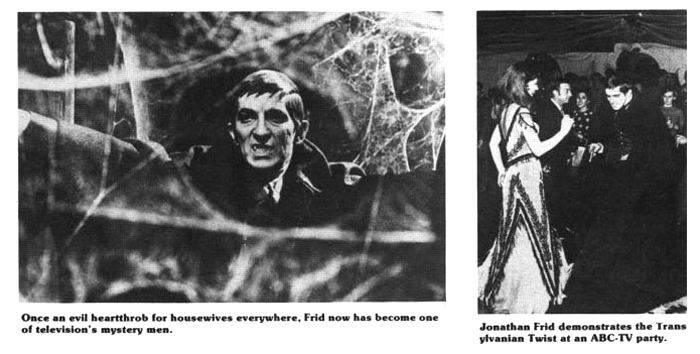
Dark Shadows, which debuted on ABC-TV on June 27, 1966, actually began as a gothic-style romance. The plot centered around Victoria Winters (Alexandra Moltke), a young woman who had accepted a position as governess with the wealthy Collins family in the village of Collinsport on the coast of Maine. Her charge was young David Collins (David Henesy), a spofled little boy prone to playing practical jokes and seeing ghosts (real or imagined?) all about the house. Also involved were David’s surly father Roger (Louis Edmonds), Roger’s sister Elizabeth Collins Stoddard (Hollywood star Joan Bennett!) and her daughter Carolyn (Nancy Barrett). The show plodded along for its first eight or nine months with a gothic and supernatural tones. Even then it was not a ‘”typical” soap in that there were no pregnancies, extra-marital affairs or the inevitable coffee-in-the-kitchen scenes that abounded on other soaps at that time. But the show didn’t seem to be catching on, so in April of 1967, with cancellation lurking in the wings, producer Dan Curtis ordered the writers to pull out all the stops and introduce a vampire into the storyline. Not having an inkling of the tremendous response that was in store. it was decided that Barnabas would be quickly written out after a few weeks (which Was considered sufficient time to pump up the ratings). In casting the role of Barnabas, Curtis chose a Canadian actor whose background was largely on the classical stage and who had appeared only briefly on an earlier soap. Little did anyone know that the name of Jonathan Frid was soon to become a household word.
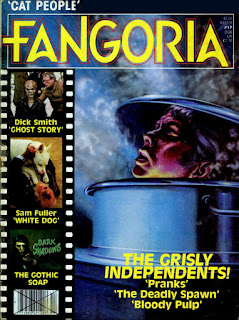
Barnabas, as portrayed by Frid, soon became what several writers phrased “the man you love to hate.” His evil actions included holding young ingenue Maggie Evans (Kathryn Leigh Scott) prisoner in a secret room the family mausoleum in hopes of making her his vampire bride, attempting to strangle Dr. Julia Hoffman (Grayson Hall) when she first discovered his secret, forcing her to murder her asssociate Dr. Dave Woodard when he found out the goings-on and any number of other disreputable doings. But in the same way as the current-day ‘J.R.’ character of TVs Dallas affects viewers, Frid’s Barnabas soon became a heart-throb for literally millions of viewers. Frid’s fan mail was overflowing with pleas for him to bite viewers on the neck and included many requests of an even more provocative nature. Barnabas had suddenly become a teen idol and, as his character became sympathetic and likeable, he graduated to hero figure.
During this hectic time in his career Jonathan Frid was more than cooperative. He did endless interviews, personal appearances and the like. His face saturated the pages of teen magazines and his volume of fan mail was mountainous. Merchandising items began to appear - bubble gum cards, comic books, a short-lived newspaper strip, dozens of paperback novels, records, board games - all bearing Frid’s likeness. For Jonathan Frid as Barnabas Collins had suddenly become the nucleus of Dark Shadows and was to consistently remain the show’s most popular character throughout its run.
Viewers figured that a centuries-old vampire must have a very interesting background, and the writers gratified their curiosity by taking them on a journey into the past to discover how Barnabas’ affliction came about. Via a seance, the family governess Victoria was transported back through time to the year 1795 where she encountered not only a youthful Barnabas, but other members of the Collins family who looked exactly like their modern-day descendants. The entire cast of regulars had been recast into new roles, some of them changing rather drastically. Mild-mannered lawyer Tony Peterson (Jerry Lacy) now appeared in the form of fanatical witch-hunter Reverend Trask. Maggie’s boyfriend Joe Haskell (Joel Crothers) became the scheming opportunist Lt. Nathan Forbes and housekeeper Mrs. Johnson (Clarice Blackburn) was the prudist and suspicion-laden Abigail Collins. Victoria was accepted into the household (again as a governess) and Barnabas’ story began to unfold. Along with the aforementioned characters, a beautifulblonde witch named Angelique (Lara Parker) was introduced and soon became another of the show’s most applauded evil-doers.
The 1795 excursion stretched out over a period of four-and-a-half months. This plot idea was something new, unique and exciting and these episodes (along with those just after Barnabas’ arrival in and the episodes for the major part of were certainly the “golden days” of Dark Shadows.
Dan Curtis knew that adding more supernatural beings to his storylines could only make an already successful formula potent. Upon Vicky’s turn to the present (where time had been suspended) new menace-makersfollowed in quick succession. Angelique reappeared (in the guise of Cassandra Collins) followed by mad Dr. Eric Lang (Addison Powell), his man-made creation Adam (Robert Rodan), Adam’s mate Eve (Marie Wallace), warlock Nicholas Blair (Humbert Allen Astredo), vampire Tom Jennings (Don Briscoe) and his werewolf brother Chris (also Briscoe). Plots were largely being ‘borrowed’ from the classic Universal films of the 1930s and 40s, and viewers delighted in each one.
The show zipped along at a fairly rapid rate until the final months of 1968 when Dan Curtis decided that a major new character should be brought into the show. The new addition was Quentin Collins, a malevolent spirit who, along with female ghost Beth Chavez (Terry Crawford), was taking possession of young David and his friend Amy (Denise Nickerson). The Turn of the Screw by Henry lames was the writers’ inspiration this time around, and their evil Quentin was portrayed by a tall young actor named David Selby. A new heart-throb was born and Quentin soon became the focal point of the story. No doubt Jonathan Frid was pleased with this change as some of the work load would be removed from his caped shoulders. It wasn’t long before another journey into the past (1897) was taking place and Quentin’s background was told in detail.
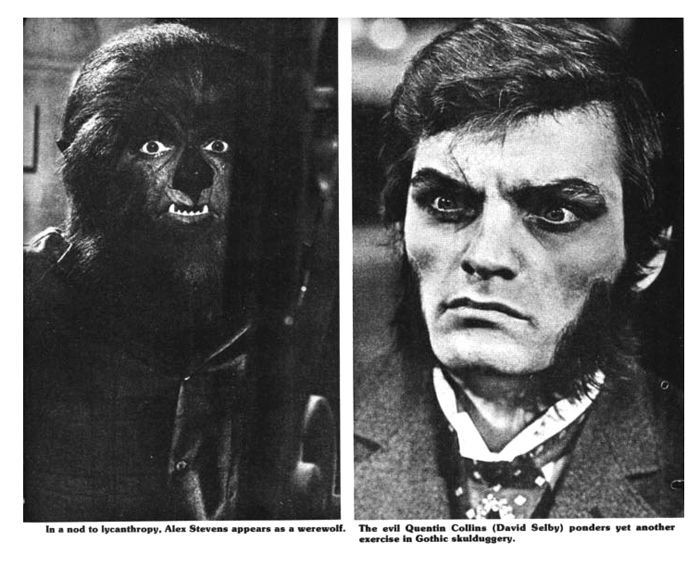
The 1897 storyline had a lengthy run of approximately seven months. During this time the cast was doing double-duty by appearing in the first full-length movie version of the show which was being filmed simultaneously by Dan Curtis Productions in associa-tion with Metro-Goldwyn-Mayer. The Lyndhurst mansion and estate in Tarrytown, New York became “Collinwood” for the film and most of the regular cast were used in their original roles. Titled House of Dark Shadows, it was basically a slightly reworked version of the initial Barnabas plot from the series and was highly successful.
By the time the daily 1897 sequences were drawing to a close, the show’s popularity had waned just a bit. The dally episodes were not too involved and moved at such a breakneck pace that unless one was watching each and every day, the story was impossible to follow. Actors were ‘killed off’ as one character and brought back in the same week as another. Plot inconsistencies abounded, and even the most devoted fans were sometimes thoroughly confused.
A change for the better wasn’t immediately forthcoming when, upon the story’s return to the present (now late 1969), the writers introduced a ridiculous plot about a supernatural race of blob-like creatures called “Leviathans” who could take on human form. The writers had been successful with their reworkings of the classic horror films of the 1930s and 40s but werenow drawing upon a kind of 1950s science-fiction element that just didn’t work in the realm of Shadows. Even with the addition of another potential young heartthrob (Christopher Pennock) the show was becoming difficult to watch. Plot inconsistencies and complicated storylines could be forgiven, but out-and-out boredom could not.
After what seemed an eternity the “Leviathan” story was wrapped up and the writers’ next step was a jaunt into “parallel time.” It was discovered that one of the rooms in the deserted west wing of the house contained a mysterious time running parallel to 1970. The people seen inside the room when these chan es occurred all looked physically like their regular 1970 counterparts but their personalities and relationships were entirely differenl. This new premise was intriguing but what initially began as a promising new direction (“Jekyll and Hyde” and “Rebeccca”- influenced plots were introduced, among others) soon became another confused shambles.
When it came time to leave parallel time 1970, Barnabas and Julia attempted to return home, but landed instead in the future years of 1995, where they found the Collinwood mansion in ruins. So, after a brief stop back in the present, the two traveled to 1840 to try to prevent the death and destruction that would befall Collinwood and its residents unless history could be changed.
With the introduction of 1840 the show continued an already steady decline, A new villain Gerard Stiles (James Storm) was introduced, along with a new ingenue Daphne Harridge (future “Angel” Kate Jackson), but neither struck the spark that would grab viewer interest. Most of the more popular regulars were back in various new guises, but somehow the goings-on were becoming stale. By late 1970 the show was in serious ratings trouble and, sensing the impending doom, several mainstays of the cast departed including Kathryn Leigh Scott and Jerry Lacy.

The final phase of the show took place in parallel time 1840 and was certainly the most dismal of all cycles the show had gone through. David Selby had exited to star in the second Shadows movie and. while he was always a close second to Frid in popularity, his departure from the show dealt it a major blow. The storyline now concerned an annual lottery the family participated in to send some unlucky member to spend the night in a haunted room in one of the deserted wings of the house. Something evil lurked there and persons had been known to go insane or die inside it.
Other than this supernatural element the rest of the plot was a Wuthering Heights-type romance centering around Bramwell and Catherine, portrayed by Jonathan Frid and Lara Parker. For the first time in Shadows history these two former arch-enemies were now cast as lovers. This fatal mistake, along with the addition of several lack-lustre new cast members and an attempt to slant the feel of the show toward romance rather than the supernatural, were the final factors in the show’s ultimate demise. The dreaded cancellation was forthcoming and Dark Shadows broadcast its final episode on April 2, 1971.

The second film version, Night of Dark Shadows had been filmed during the last months of the show’s run and featured David Selby and Kate Jackson as newlyweds Quentin and Tracy Collins. Also on hand were John Karlen and Nancy Barrett as their writer friends Aiex and Claire Jenkins, Grayson Hall as housekeeper Carlotta Drake, James Storm as handyman Gerard Stiles and Lara Parker as the evil spirit of Angelique Collins. The film was a beautifully photographed mood piece and was technically superior to House Dark Shadows but was marred by several editing cuts before its release. This, along with the tact that the TV show had already the airwaves before Night’s release, spelled box-office disappointment and put an end to any plans Curtis and MGM might have had for further sequels.
Today, having been off the air 10 years, the show’s loyal fans remain and a whole new generation of Shadows fans sprung up a years ago when Worldvision Enterprises syndicated reruns of the show to various stations around the Country. Unfortunately there were major problems of an undisclosed nature between the syndicators and local stations, and the re-runs are seen in very few (if any) markets today. Nevertheless, continued interest remains as evidenced by the tact that there is a yearly convention for the show held in California, along with fan clubs and publications that still abound throughout the country.
Since its demise there has always been speculation if the show could ever be revived, but it seems that prospects for the success of a new version of the show would be slim. Dark Shadows was a success largely due to the climate of the country at the time of its run. The show was Something new, different and fun. It’s form of escapism took us through the Vietnam war, the hippie movement, long hot summers of racial unrest, and more. Today the exploits of Barnabas and the Collins clan might seem ludicrous and laughable. As it stands now, Dark Shadows is and must remain a memory of the distant past.
